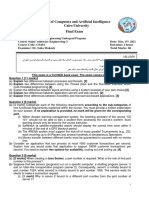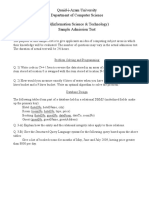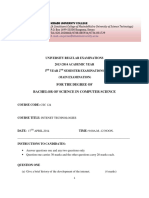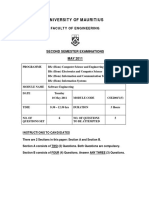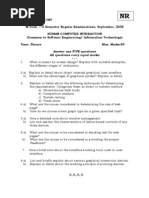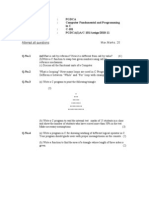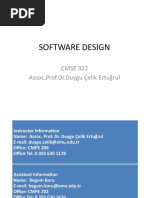0 ratings0% found this document useful (0 votes)
55 viewsCase Study: A Card Verifier That Controls The Access of The Visitor of A Building Through The
This document contains instructions for a comprehensive examination for a course on software for embedded systems. It includes 4 questions. Question 1 involves analyzing the functional and non-functional requirements, use cases, architecture, and timing diagrams for an access control system using card verification. Question 2 involves developing a mobile text entry application with auto-completion and spell-check under specified real-time, embedding, and robustness constraints. It asks for use cases, sequence diagrams, quality of service diagrams, and initial class diagram. Question 3 asks what aspect of collaboration the observer pattern optimizes. Question 4 asks about task structuring criteria for real-time embedded systems and concurrent task structuring issues.
Uploaded by
Shivam ShuklaCopyright
© © All Rights Reserved
Available Formats
Download as PDF, TXT or read online on Scribd
0 ratings0% found this document useful (0 votes)
55 viewsCase Study: A Card Verifier That Controls The Access of The Visitor of A Building Through The
This document contains instructions for a comprehensive examination for a course on software for embedded systems. It includes 4 questions. Question 1 involves analyzing the functional and non-functional requirements, use cases, architecture, and timing diagrams for an access control system using card verification. Question 2 involves developing a mobile text entry application with auto-completion and spell-check under specified real-time, embedding, and robustness constraints. It asks for use cases, sequence diagrams, quality of service diagrams, and initial class diagram. Question 3 asks what aspect of collaboration the observer pattern optimizes. Question 4 asks about task structuring criteria for real-time embedded systems and concurrent task structuring issues.
Uploaded by
Shivam ShuklaCopyright
© © All Rights Reserved
Available Formats
Download as PDF, TXT or read online on Scribd
You are on page 1/ 1
Birla Institute of Technology & Science, Pilani
Work-Integrated Learning Programmes Division
Second Semester 2009-2010
Comprehensive Examination (EC-2 Regular)
Course No. : IS ZC424
Course Title : SOFTWARE FOR EMBEDDED SYSTEMS
Nature of Exam : Open Book
Weightage : 60%
Duration : 3 Hours
Date of Exam : 04/04/2010 (FN)
Note:
1. Please follow all the Instructions to Candidates given on the cover page of the answer book.
2. All parts of a question should be answered consecutively. Each answer should start from a fresh page.
Q.1. Case Study: A card verifier that controls the access of the visitor of a building through the
card. The system has a small sensor to detect the card and read the bar code to identify the
card. Then the system will search the code inside a list of codes that are authorized and
have the access inside the building. If the code matches, it will generate a signal to release
the lock for the gate. Otherwise it will show a red light on the front monitor and a user
friendly message such as Card not authorized. If an unauthorized card is put inside the
slot for a maximum number of times, the system will generate an alarm.
(a). List the functional and non functional requirements of the above mentioned
system.
(b). Describe the above mentioned Card Verification System (CVS) with appropriate
Use case diagram(s).
(c). Suggest a suitable architectural design for the above mentioned system.
(d). Show the dynamic aspects of the system with the help of sequence/timing
diagrams.
(e). Identify the various timeliness constraints of the system.
(f). Explain Concurrency and Scheduling issues of the system.
(Note: Use UML 2.0 notations wherever applicable.) [4+5+4+7+2+3=25]
Q.2. Case Study: Our goal is to develop an application to enter text (e.g. Short Messages)
more efficiently using a mobile phone keyboard. It includes auto-completion of text while
it is being typed and performs spell-checks.
Real-time Constraints
o Completion should decide the next character within 20% of the time taken by
the user between 2 key presses.
o Spell-check should happen incrementally (per word)
Embedding Constraints
o Dictionary size (memory limitation) vs. usability of feature.
Robustness Constraints
o Dictionary must be editable should allow user to enter variations of words.
(a). Describe the system with the help of use case diagram.
(b). Explain the text completion and correctness process with the help of sequence
diagram(s).
(c). Show the QoS (Quality of Service) requirements of the system with suitable UML
diagram(s).
(d). Show the design of the system by showing initial class diagram with proper
associations. [5 + 5 + 4 + 6 = 20]
Q.3. What aspect of collaboration does the observer pattern attempt to optimize? [7]
Q.4. What are the various task structuring criteria used for a RT embedded system. Explain the
concurrent task structuring issues in detail. [8]
*******
No. of Pages = 1
No. of Questions = 4
You might also like
- ISTQB Advanced Level Technical Test Analyst- Exam Insights: Q&A with ExplanationsFrom EverandISTQB Advanced Level Technical Test Analyst- Exam Insights: Q&A with ExplanationsNo ratings yet
- Self Study: Comparative Study of Arm Cores - Armv4 To Arm Cortex100% (1)Self Study: Comparative Study of Arm Cores - Armv4 To Arm Cortex4 pages
- Technological Institute of The PhilippinesNo ratings yetTechnological Institute of The Philippines2 pages
- IFT4302_PROGRAMMING WITH DOT NET FRAMEWORKNo ratings yetIFT4302_PROGRAMMING WITH DOT NET FRAMEWORK2 pages
- BSC ITIM 4th Sem Question Paper May 2012No ratings yetBSC ITIM 4th Sem Question Paper May 201229 pages
- Faculty of Computers and Artificial Intelligence Cairo University Final ExamNo ratings yetFaculty of Computers and Artificial Intelligence Cairo University Final Exam4 pages
- Software Design and Architecture JUNE-2021 Sem - II SET-4 (T.Y.B.tech COMP)No ratings yetSoftware Design and Architecture JUNE-2021 Sem - II SET-4 (T.Y.B.tech COMP)6 pages
- M.tech (2nd Sem) Previous Paper For C.S.E.,May 2011, PTUNo ratings yetM.tech (2nd Sem) Previous Paper For C.S.E.,May 2011, PTU10 pages
- 2020 ISS332 Systems Administration EXAM ASSIGNMENT PDFNo ratings yet2020 ISS332 Systems Administration EXAM ASSIGNMENT PDF4 pages
- Real Time Operating System (IDE) : USN TEE02No ratings yetReal Time Operating System (IDE) : USN TEE022 pages
- Object Oriented Programming: The Bcs Professional Examinations BCS Level 5 Diploma in ITNo ratings yetObject Oriented Programming: The Bcs Professional Examinations BCS Level 5 Diploma in IT4 pages
- Exam. Code: 107206 Subject Code: 1736: Bachelor of Computer Application (BCA) 6 Semester Software Engineering Paper-IINo ratings yetExam. Code: 107206 Subject Code: 1736: Bachelor of Computer Application (BCA) 6 Semester Software Engineering Paper-II2 pages
- SPC 2202 Object Oriented Analysis and Design Year II Semester INo ratings yetSPC 2202 Object Oriented Analysis and Design Year II Semester I3 pages
- NR-410209-Principles of Software EngineeringNo ratings yetNR-410209-Principles of Software Engineering5 pages
- Cse Programming For Problem Solving Model Question Papers 1No ratings yetCse Programming For Problem Solving Model Question Papers 14 pages
- Object_Oriented_Software_Engineering_Solved_FullNo ratings yetObject_Oriented_Software_Engineering_Solved_Full5 pages
- Sample of Object Oriented Software Development Exam (Dec 2006) - UK University BSC Final YearNo ratings yetSample of Object Oriented Software Development Exam (Dec 2006) - UK University BSC Final Year10 pages
- Software Design and Architecture JUNE-2021 Sem - II SET-5 (T.Y.B.tech COMP)No ratings yetSoftware Design and Architecture JUNE-2021 Sem - II SET-5 (T.Y.B.tech COMP)6 pages
- FAI - Assignment Sheet (Both Assignments)No ratings yetFAI - Assignment Sheet (Both Assignments)5 pages
- Attempt Any Five Questions (5 6 30 Marks)No ratings yetAttempt Any Five Questions (5 6 30 Marks)3 pages
- ECSE 3106 Operating System Principles and Design ExamNo ratings yetECSE 3106 Operating System Principles and Design Exam2 pages
- Java / J2EE Interview Questions You'll Most Likely Be AskedFrom EverandJava / J2EE Interview Questions You'll Most Likely Be AskedNo ratings yet
- Objective: Classification Using ID3 and C4.5 Algorithms TasksNo ratings yetObjective: Classification Using ID3 and C4.5 Algorithms Tasks8 pages
- Self Study: Atmel Atmega128 Architecture: Anupama KR & Meetha.V.Shenoy Embedded System Design 8051100% (1)Self Study: Atmel Atmega128 Architecture: Anupama KR & Meetha.V.Shenoy Embedded System Design 80515 pages
- Home Work 2: Dead Line March 10 - 8 Am Both Questions Are To Be AttemptedNo ratings yetHome Work 2: Dead Line March 10 - 8 Am Both Questions Are To Be Attempted1 page
- Software Design: CMSE 322 Assoc - Prof.Dr - Duygu Çelik ErtuğrulNo ratings yetSoftware Design: CMSE 322 Assoc - Prof.Dr - Duygu Çelik Ertuğrul21 pages
- Đề Thi Cuối Kỳ Học Kỳ 1, Năm Học 17-18 Môn: Hệ Thống Truyền Động ServoNo ratings yetĐề Thi Cuối Kỳ Học Kỳ 1, Năm Học 17-18 Môn: Hệ Thống Truyền Động Servo4 pages
- SE - HRMS - RequirementsTracebility Matrix v2.0 DT 27-12-23No ratings yetSE - HRMS - RequirementsTracebility Matrix v2.0 DT 27-12-2322 pages
- Resume Himanshu 7 Years of Experience On Functional, API, AutomationNo ratings yetResume Himanshu 7 Years of Experience On Functional, API, Automation4 pages
- Specification For Fire and Gas Detection System100% (7)Specification For Fire and Gas Detection System48 pages
- ITPE 103 - Web Systems and Technologies-1No ratings yetITPE 103 - Web Systems and Technologies-192 pages
- Bcs Higher Education Qualifcations: BCS Level 5 Diploma in ITNo ratings yetBcs Higher Education Qualifcations: BCS Level 5 Diploma in IT12 pages
- Copy of nasscom - Hackathon Sample Project with templateNo ratings yetCopy of nasscom - Hackathon Sample Project with template6 pages
- Software Quality Assurance Plan: Open Source Project 2008No ratings yetSoftware Quality Assurance Plan: Open Source Project 200817 pages
- Compatibility Test For Frontend Developers PDFNo ratings yetCompatibility Test For Frontend Developers PDF3 pages




















